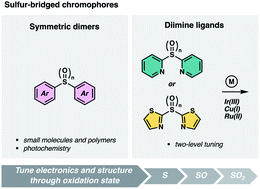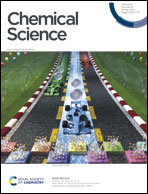Sulfur-bridged chromophores for photofunctional materials: using sulfur oxidation state to tune electronic and structural properties
Abstract
The use of a heteroatom, such as sulfur, as a linker or bridge, in π-conjugated materials has advantages over purely carbon-based ones due to the accessibility of higher oxidation states as a result of hypervalence. Materials containing a sulfide bridge (S) can be systemically oxidized into sulfoxides (SO) and sulfones (SO2), each of which can then influence how a material interacts with light, playing a large role in dictating the photophysical and sometimes photochemical properties. In this perspective, we summarize the progress that our group and others have made, showing how oxidation of a sulfur bridge in symmetric bichromophoric dimers and in diimine ligands can influence the excited state behavior in organic π-conjugated materials and metal complexes.

- This article is part of the themed collection: 2022 Chemical Science Perspective & Review Collection


 Please wait while we load your content...
Please wait while we load your content...